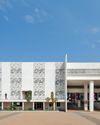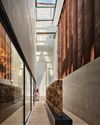During the early post-Independence Nehruvian era when bright, young, foreign-trained Indian talent was engaged for building upcoming government funded institutions, campuses, housing, industrial townships or monuments – even a few cities like Chandigarh, Gandhinagar and Bhubaneshwar – there was an air of exciting idealism and challenge in building a new India.

The reward for being architects of this Indian renaissance was not just monetary—driving around in BMWs or being part of the jet-setting, cocktail circuit hiring event managers or media advisers for carving out stardom—but to make genuine reputations, identity and usher in a truly Indian modernism. New talent got noticed through scrupulously managed design competitions, impeccable juries and getting published in a handful, but quality journals produced by a dedicated few. This momentum got further boost with the advent of events like the Asiad and the Indian Trade Fair at Pragati Maidan in the 1970s. This birthed the next wave of Indian architects and brilliant, innovative structural engineers who collaborated to go beyond the early influence of Le Corbusier and Louis Kahn’s great impact. The search for a truly Indian modernism began to show results by going back to the eternal principles of climate, play of light and shade, scale, detail and fusion of art and architecture as interpreted from the traditional architecture and transformed into Modernism. The construction and structural materials remained primarily brick, reinforced concrete and stone.
It was only in the 1990s that, with the opening of the economy to globalisation, new materials and technologies began to make an appearance.
Emergence of IT Parks:
Esta historia es de la edición December 2016 de Architecture + Design.
Comience su prueba gratuita de Magzter GOLD de 7 días para acceder a miles de historias premium seleccionadas y a más de 9,000 revistas y periódicos.
Ya eres suscriptor ? Conectar
Esta historia es de la edición December 2016 de Architecture + Design.
Comience su prueba gratuita de Magzter GOLD de 7 días para acceder a miles de historias premium seleccionadas y a más de 9,000 revistas y periódicos.
Ya eres suscriptor? Conectar

A RIVERSIDE SANCTUARY OF DESIGN AND ART
Perched along the Chao Phraya River, Capella Bangkok is an urban sanctuary crafted by Hamiltons International and BAMO, with art by Thai textile artist Ploenchan 'Mook' Vinyaratn-blending with Bangkok's cultural heartbeat to offer an experience that is both timeless and refined
THE SPORTING ICON
A manifesto of potential written in zinc, concrete, and imagination, this university sports arena showcases how thoughtful, innovative architecture can transform urban landscapes and foster a culture of excellence

NATURE NURTURES LEARNING
Blending sustainability with innovative design, Morphogenesis' Vidyashilp Academy redefines educational spaces, fostering holistic development amidst Bengaluru's lush greenery

ME EPICENTER OF ART AND CULTURE
Arthshila at Okhla endeavours to epitomize the essence of exhibition spaces within the context of Delhi

SAKA MUSEUM: BRIDGING SILENCE, HERITAGE, AND DESIGN
From the celestial glow of its lobby to the grounded textures of volcanic rock, the SAKA Museum is a masterclass in thoughtful, place-based design. Under the vision of Wesley Ho, co-founder of the Hong Kong-based firm Napp Studio & Architects, this design-forward museum has evolved into a living, breathing narrative of Bali's identity

SCHUECO INDIA INAUGURATES ITS INDIA WELCOME FORUM IN DELHI NCR
A celebration of innovation, sustainability, and luxury in architecture

PIONEERING DESIGN EDUCATION FORA BETTER WORLD
To commemorate the 10th Anniversary of The Design Village - India's first social design school, we talk to the leadership at the institute that carries its pioneering vision of education for social impact, winning the Don Norman Design Recognition for humanity-centered design, representing the Global South.

DIVIANA DEBUTS IN MILAN: A Landmark In Indian Luxury Design
In an extraordinary milestone for Indian luxury and design, DIVIANA, a premier Indian luxury furniture brand, has opened its first European flagship showroom in Milan's prestigious Montenapoleone District, at Via Monte di Pietà 13/1. This 3200 sq. ft. space seamlessly blends the rich heritage of Indian craftsmanship with the refined aesthetics of Italian design, establishing a bold new narrative for global luxury.

THE MASTER BUILDER
Architect Ayan Sen is committed to pushing the boundaries of design and innovation.

MASTERING THE ART OF DESIGN
In a candid chat with A+D, Nieves Contreras, Creative Director, Lladró speaks about her innate passion for design and her love for craftsmanship